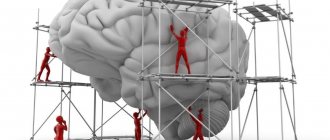Neurolinguistic programming is a popular and hotly debated area of practical psychology. The relevance of this subject is due to a number of reasons.
Firstly, NLP methods are at the intersection of several disciplines: psychology, psychotherapy, programming and linguistics. Secondly, NLP is a new research direction aimed mainly at practical applications in human life. In addition, although neuro-linguistic programming is often criticized by the academic community, this discipline contains a large number of useful and “working” techniques, which will be discussed in the lessons of this section.
In this online training, you will learn for free how to use key NLP techniques: metamodel, framing, reporting, anchoring, working with states and representational systems, and also get acquainted with the best practices, games, books, videos on this topic.
What it is?
NLP (Neurolinguistic programming) is a field of practical psychology that develops applied techniques that model the techniques and practices of famous psychotherapists and communication masters.
In other words, NLP studies the positive experience of specialists in the field of psychotherapy, Gestalt psychology, psychoanalysis, linguistics, hypnosis, with the goal of using this experience in the future. Essentially, NLP is about modeling the techniques of successful people in order to make these techniques available to the public.
It is worth noting that NLP is not a science, and knowledge, due to the nature of its acquisition, cannot be fully scientifically verified. Moreover, the scientific community is skeptical about this area, and it is rare to find NLP courses in universities. But it is important to understand that the creators of NLP did not have the goal of making a full-fledged scientific theory. It was important for them to find publicly available techniques, revealing the complex techniques of famous psychology practitioners.
[edit] The essence of scam
Office plankton, rednecks and schoolchildren uncontrollably believe that with the help of certain techniques, special words and gestures they can easily convince and brainwash people, easily achieve success and generally be cooler than ordinary pathetic people. As a result, they voluntarily give hundreds of oil to scammers who promise to train them. In fact, the “knowledge” they received is a cheap lie that has no practical use. As a result of the study, trying to tailor their movements and speech “to the interlocutor,” they begin to move like paralytics or puppets, stutter and react nervously to every eye movement. The only ones who get the profit promised by the scammers from this are the scammers themselves. In those cases when NLP works, it turns out that everything would have worked without NLP, but the adherent of the teaching does not give a damn about this, because it is easier to believe that you have not wasted a lot of money and the whole world is at your feet, than to admit to yourself your idiocy.
Short story
Collaborative work on the creation of neurolinguistic programming was started in the late 1960s by a group of specialists from the University of California: Richard Bandler, John Grinder, Frank Pucelik, led by their scientific trustee, the famous anthropologist Gregory Bateson. The NLP system was developed to answer the question of why certain psychotherapists interact so effectively with their clients.
Instead of exploring this issue from the point of view of psychotherapeutic theory, Bandler and Grinder turned to analyzing the methods and techniques used by these psychotherapists by observing the progress of their work. The scientists then grouped the methods they studied into different categories and presented them as general models of interpersonal relationships and how people influence each other.
The famous specialists whose professional experience it was decided to transform into models were chosen:
| ✔ | Virginia Satir - family therapy. |
| ✔ | Milton Erickson - Ericksonian hypnosis. |
| ✔ | Fritz Perls - Gestalt therapy. |
The first results of studying the practical skills of these psychotherapists appeared in 1975 and were published in the work “The Structure of Magic. Volume 1" (1975). Then, extended research materials on the model were presented in the books “The Structure of Magic. Volume 2" (1976) and "Changes in the Family" (co-authored with Virginia Satir, 1976).
The result of this work was the so-called Meta Model, which you will learn about in the first lesson of our training. This model served as the foundation for further research in this area and led to the creation of a whole area of practical psychology. Today NLP is an open methodology that has many followers, complementing it with proprietary developments.
You can read more about the history of NLP on Wikipedia.
The first groups 1972 - 1973
In the early seventies, an extremely liberal atmosphere reigned at the University of California, Santa Cruz; the classes were not dominated exclusively by scientific orthodox views. Kresge College, where Gregory Bateson then worked, was especially popular among psychology students. There it was possible to carry out experimental group activities.
Richard Bandler
In the spring of 1972, Bandler, frustrated by the foreign content of the academic curriculum, organized classes in the practice of Gestalt therapy at Kresge College, taking advantage of the opportunity given to final-year students to plan and conduct their own classes. Students participating in such classes received documents confirming their completion, which were also recognized as those issued by professors.
Working with Gestalt theory was absolutely new in the behaviorist-oriented educational process at that time. And although there were two groups dealing with issues of human sensations, their principles came mainly from the concept of Carl Rogers, the creator of client-centered therapy. He was one of the fathers of the so-called humanistic psychology, which was born in 1962 at the Society for Humanistic Therapy as a third force in psychology, along with the then dominant schools of psychoanalysis and behaviorism. During this time, Rogers' non-directive and growth-oriented views entered the salons and advanced academic circles. This, among other things, was expressed by the great activity of encounter groups, the creation of which was fashionable in many higher educational institutions.
Despite many programmatic similarities with the foundations of Perls's Gestalt therapy (belonging to the so-called humanistic therapy), the work of these groups, in the seventies, was in principle directed rather towards group dynamics and concentrated on the movement of authenticity. Therefore, Bandler's group was significantly different from ordinary meeting groups. From the very beginning he was interested in analyzing the therapeutic effects of Gestalt theory within a group. In addition, the exercises at the seminars opened up the opportunity for him to develop his own practical competence, which until that time remained only in theory.
Application of NLP skill
NLP tries to teach people to observe, understand and influence themselves and others as effectively as experienced psychotherapists and communication masters do. Therefore, NLP has a wide range of applications, which can include such areas as:
- psychotherapy,
- time management,
- oratory,
- education,
- management and management,
- sales,
- acting,
- jurisprudence,
- writing and journalism.
NLP allows you to develop the communication skills that every person needs. In addition, NLP helps personal development: the ability to correctly understand your emotional states, perceive the world around you in a diversified way, and achieve flexibility in behavior. Advanced NLP techniques allow you to treat phobias and psychological trauma, maintain good mental shape and maintain a high level of performance.
If you want to find out to what extent, even at an intuitive level, you now know NLP techniques and can apply them to develop your career, we invite you to solve the case:
Statistics Full screen
How to learn it
In accordance with the main principles of NLP, almost any person is able to master all the techniques of this theory. As a rule, popular training centers distinguish three main stages of training in neurolinguistic programming:
| 1 | NLP practitioner course: learning NLP skills and the ability to apply them in practice. |
| 2 | NLP Master course: in-depth study of NLP techniques. |
| 3 | NLP trainer course: ability to work with an audience and knowledge of the features of teaching NLP. |
Often, trainings can last several weeks and can be quite expensive, but face-to-face courses are not the only way to learn the basics of neurolinguistic programming. After researching the experience of teaching this skill, we came to the conclusion that all NLP techniques (or at least most of them) can be learned independently. We have prepared a number of lessons that will help you develop useful competencies for full mastery of the techniques of this psychological direction.
Want to test your knowledge?
If you want to test your theoretical knowledge on the topic of the course and understand how suitable it is for you, you can take our test. For each question, only 1 option can be correct. After you select one of the options, the system automatically moves on to the next question.
Statistics Full screen
NLP lessons
The goal of our online course is to teach you how to use the fundamentals of Neuro Linguistic Programming taught in basic NLP classes. In our training you will not find a complete course in hypnosis and NLP aerobatics, but we have tried to present all the key techniques and concepts that underlie hypnosis and advanced concepts.
If you just want to get acquainted with the basics of NLP, then you can take the lessons presented below. Lessons 1 and 2 cover language patterns, Lessons 3 and 4 cover nonverbal communication techniques, and Lesson 5 covers effective self-development techniques.
Lesson 1. Language model or NLP metamodel
One of the earliest and most popular concepts in NLP is the language model or, as it is called, the metamodel. This model helps to better understand the meaning of human speech. The thing is that when expressing our thoughts, we cannot absolutely accurately convey to our interlocutor what we are thinking about. We miss something, believing that it is already clear, and we unintentionally distort something. But can our interlocutor, colleague, or subordinate understand us correctly?
Not always, unless you are a good psychotherapist or psychoanalyst. To properly understand a person, professional psychotherapists ask him special questions that help them enter the deep structure of human thoughts. The metamodel of neurolinguistic programming described in this lesson will help you better understand a person, and in some cases even change his own perception through the use of special psychotherapy techniques.
Lesson 2. Framing and positions of perception
In this lesson you will learn two useful NLP techniques. The first of them, framing, will teach you to frame your thoughts in various frames (frame, translated from English as frame), which will undoubtedly help you develop communication skills. The second technique will allow you to work with five positions of perception and representation of reality. Both of these models can actively influence your speech, making it more flexible.
Lesson 3. Representational systems
In the previous two lessons you were introduced to the key linguistic techniques of NLP. However, no less important in neurolinguistic programming are models for understanding neuroprocesses and their impact on the human psyche. In this lesson we will talk about the influence of the senses on the interpretation of a person’s experience.
Lesson 4. Report, calibration, adjustment
The physiological processes accompanying the moment of communication are no less important than speech itself. It is known that nonverbal techniques are an essential component of any act of communication. The techniques in this lesson will allow you to influence your physiological characteristics during communication, which will help you be a “comfortable” interlocutor when communicating with different people.
Lesson 5. Performance, working with states, anchoring
This lesson will examine NLP techniques aimed at increasing a person’s effectiveness, as well as its impact on one’s own nervous processes. Not many people know that today’s popular methods of improving performance, for example, SMART, appeared within the framework of NLP. This lesson will introduce basic models to help people manage their motivation and emotional states.
Richard Bandler
Richard Wayne Bandler was born in 1950 in New Jersey. A couple of years later, his family moved to California, where he grew up in one of the poorest parts of San Jose, the Bay Area, north of San Francisco.
In the mid-sixties, Bandler was one of the long-haired flower children that could often be found on the streets of the cities of the American West Coast. As an active member of the hippie protest community, he helped organize some of the biggest rock concerts of those years.
These times were characterized by a negative attitude towards traditions. The materialistic basis of American society, the increasingly absurd escalation of the arms race and the military intervention of the United States in the Vietnam conflict gave rise to an oppositional movement that rejected the norms of a successful society. Many young people saw the solution to the greatest problems of their time in adopting an attitude of extreme individualism. They saw a way out of the global crisis in a revaluation of values. Not the Motherland, family and success, but love, peace and personal happiness were to become the slogan of new times. The expression of this approach to life was flight from cities, drug experiences, religious mysticism and, above all, new rock music.
The summer of 1967 - known as the Summer of Love - was the heyday of the so-called West Coast music, which was associated with such famous performers as: The GratefulDead, Jefferson Airplane, Santana, The Steve MillerBand, The Birds, Coyntry Joe and the Fish, JanisJoplin iQuicksilver MessengerService. Many people met in the open air to listen to the sounds of today's legendary bands and, under the influence of psychedelic drugs such as LSD, psilocybin mushrooms and hashish, to celebrate together the peaceful revolution of the Flower Power movement.
Richard Bandler
This cultural revolution culminated during the iconic Woodstock festival. In September 1969, for the first time in history, nearly half a million people gathered on the East Coast to celebrate a new era of love, harmony and peace. Everything seemed possible. The unexpected end of this idea came on December 6, 1969, when a member of the Hells Angels, during one of the Rolling Stones' concerts at Altamont Speedway near San Francisco, killed eighteen-year-old black man Meredith Hunter in front of the stage. Thus ended the dream of the Woodstock Nation.
However, in 1967, the faith of young people in the future and the belief in the possibility of changing the face of the world was not yet broken. Becky, the wife of Robert S. Spitzer, a renowned psychiatrist and president of Sciens & Behavior Books in Palo Alto, brought her husband's attention to the amazing talents of a seventeen-year-old Fremont High School student whom she had hired to teach her son Dan to play the drums. What Becky Spitzer admired about Richard Bandler was his openness to philosophical questions and the manner in which he taught music.
Richard Bandler
The Spitzers tried their best to support Bandler's abilities. Robert Spitzer described him as extraordinarily dexterous and all-round talented. Therefore, he entrusted him with various tasks and brought him to work in the publishing house. Bandler's responsibilities included working in the store and preparing tape and video recordings for therapeutic seminars.
Bandler began his thriving academic career with a two-year stint at Foothill College in Los Altos Hills. According to Spitzer, he managed to drive some of his teachers to despair. He did not compromise, even if the issue affected only details, completely disobeying the rituals of academic life4.
After Bandler graduated from college, he attended the University of California, Santa Cruz. Spitzer and his wife, who became increasingly influential mentors to Bandler as time went on, then owned a small dacha in a village near Santa Cruz. They allowed him to build a house on their land. For some time, Bandler lived there with a girlfriend and a dog.
Santa Cruz is a small town in the north of Monterey Bay, south of San Francisco. There is a university in the city, very beautifully located. At that time, the city had about forty thousand inhabitants, leading a cultural life rich in experiments. Many famous personalities from the world of culture lived here: director Alfred Hitchcock, actress Shirley Temple, science fiction author Frank Herbert, as well as members of the group Santana and the Doobie Brothers.
Gregory Bateson
Richard Alpert, a former colleague of Timothy Leary at Harvard University, returned from India and also lived in Santa Cruz, already a spiritual master - under the name Baba Ram Dass. Alpert was, along with Ralph Metzner and Leary, a co-author of the classic work of the psychedelic movement that was to serve as a guide to the world of LSD experimentation. Gregory Bateson also lived in Santa Cruz at this time. He is the creator of cybernetic epistemology, a concept that has become the basis of the modern holistic view of the world.
In esoteric circles, to this day, Santa Cruz is considered a special “place of power.” This definition indicates the diversity of activities that have been undertaken there in recent decades to explore the spiritual, personal and general dimensions of life.
How to take classes
To successfully master basic NLP techniques you will need:
- Study the theory, and not just strive to memorize the sequence of actions.
- Train yourself by completing the course exercises.
- Try to carefully use the learned techniques in practice.
It is the constant application of the acquired knowledge in life that will allow you to truly master neurolinguistic programming. It is also important to note that applying NLP knowledge will increase your attentiveness during communication and teach you to independently model (create) successful methods and techniques.
In addition, to study NLP, it is recommended to master several general rules, the so-called presuppositions of neurolinguistic programming.
Presuppositions - basic principles of NLP
While modeling the techniques of famous psychotherapists, NLP developers identified several general simple rules that these specialists used in their works. Scientists combined the studied material into a common system of presuppositions.
Presuppositions in neurolinguistic programming (NLP) are axiomatic beliefs used as a tool to facilitate the achievement of the most effective results from the techniques used. The essence of using presuppositions is that for the most effective training of NLP, they must be accepted a priori (as an axiom). The main presuppositions of NLP are:
| 1 | The map is not the territory. Just as the most detailed map will never be an accurate representation of the territory, so the words we use do not contain an absolutely accurate representation of our experience, of which they are a representation. In NLP there are two levels of phenomena: external reality and internal subjective reality. In other words, NLP does not work with reality, or “territory,” but with subjective perceptions and beliefs about reality (“maps”). |
| 2 | The person with the most flexibility has the most influence in the system. In any system, the person with the most flexible behavior will be able to consider more choices and will therefore have more influence in the system. Accordingly, the more options you have in your communication toolbox, the less likely you are to find yourself stuck. |
| 3 | There are no defeats, only feedback. This presupposition is borrowed from William Ross Ashby's principle of the importance of feedback loops in information theory. In neuro-linguistic programming, nothing is considered in terms of “success” and “failure.” Unsuccessful results following an action are not a cause for disappointment and despair, but valuable feedback information that determines the effectiveness of what you do. |
| 4 | The mind and body inevitably influence each other. This is because the human body contains approximately 100 billion nerve cells. Most of these cells are found in the brain. Each of the hundred billion neurons is connected to at least a thousand others. And, therefore, everything in us is interconnected, especially the mind and body. |
| 5 | Personality and behavior are different phenomena. We are more than our behavior. We may do different things in different situations, and often do so unintentionally. Thus, people's behavior does not define people themselves. |
| 6 | The basis of any human behavior is a positive intention. This presupposition is borrowed from the belief system of Virginia Satir. Its essence lies in the fact that even a person's seemingly negative behavior is considered in NLP as an attempt to fulfill a positive intention (which he may not be aware of). |
These are not all the basic principles that are highlighted in textbooks on NL programming. If we put together all the presuppositions of famous NLP authors, we can make the following list:
Background assumptions regarding mental processing:
- “Map” is not “territory”.
- People's reactions correspond to their cards.
- The meaning depends on the context.
- The mind and body inevitably influence each other.
- Individual skills result from the refinement and consistency of the use of representational systems.
- We respect other people's models of the world.
- Personality and behavior are different phenomena. We are more than our behavior.
- Each behavior is practical and useful in a specific context.
- We evaluate behavior and change in terms of context and ecology.
Communicative presuppositions:
- We can't help but communicate.
- The way we communicate affects our perception.
- The meaning of communication lies in the reaction it evokes.
- The person who sets the frame of communication controls it.
- There are no defeats, only feedback.
- The person with the most flexibility has the most influence in the system.
- Resistance indicates a lack of rapport
.
Presuppositions concerning learning, choice and change :
- People have the internal resources necessary to achieve their goals.
- People are capable of learning anything in one try.
- Any communication should increase the number of available alternatives.
- When performing any action, people choose the best option available to them at the moment.
- We can control our brains and control the results.
You can read more about presuppositions in NLP in the textbook “NLP Practitioner”, as well as on Wikipedia.
Exercises
Many people who are only superficially familiar with NLP believe that it is primarily a technique for manipulating people. Unfortunately, this opinion was formed in the conditions of modern society, in which every successful person must be able to achieve his goals by any means. Initially, neurolinguistic programming was developed as a method of helping those who suffer from their own imperfections, complexes and self-criticism. It is actively used by many psychologists to restore mental balance and increase self-esteem. But you can do it yourself.
Find useful practical applications for NLP - get rid of your own cockroaches in your head by mastering just a few exercises.
“It’s not an elephant, it’s a fly!”
Agree that most problems are actually a snowball. It is human nature to constantly think about what worries him, to examine this something from all sides, looking for some new facets. Speculation, doubts, fears grow and any minor unpleasant incident turns into a huge insoluble tangle of difficulties.
There is an exercise in NLP that suggests going the other way and turning this scary, bloated elephant into a small and meaningless fly.
- Create a relaxing atmosphere. Make sure no one disturbs you.
- Imagine in every detail the thing (event) that worries you: how you were fired, how you lost your wallet, how you got divorced. This should be the brightest picture possible.
- Now desaturate it so that it resembles a vintage black and white photograph.
- Begin to mentally move it further and further away from your inner gaze until it turns into a point on the horizon.
- Peer at it, try to consider the details until you get tired and get tired of it.
Last step. Now find something positive in your life that is much bigger than this problem. For example, you were fired, but your children are alive and well. If something happened to them, it would be a hundred times more painful. Lost your wallet? But you have a solid NC on your card. You didn’t become a beggar and a homeless person after that. Divorced? Didn’t it become easier to breathe after that and didn’t you have more free time for yourself?
In short, NLP suggests turning the bad elephants in your life into worthless flies. Try it yourself and see the incredible effectiveness of the exercise.
"Big Wash"
This exercise works great if a particular picture does not allow you to live in peace. It happens that after an unpleasant situation you want to forget about it as quickly as possible, but in your mind it keeps popping up in the smallest details of how it all happened. Because of this, people cannot fall asleep, eat peacefully, or communicate. No amount of distracting maneuvers (throwing yourself into work, for example) helps. This means it’s time for neurolinguistic practice.
- Don't artificially evoke a disturbing memory. Wait for the moment when it comes to mind on its own.
- Don't drive him away, don't try to hide from the problem.
- Mentally imagine this picture as a dirty spot on your clothes. Set yourself the task of cleaning it up.
- Imagining everything in detail, in your thoughts take out a bowl of water, pour the best bleach into it, add powder and start zealously washing this picture.
- Imagine how the spot becomes lighter and lighter, and then completely disappears.
Psychologists and psychotherapists suggest performing the neurolinguistic exercise “The Big Laundry” for paranoia and obsessive thoughts.
"The Musketeers 20 Years Later"
One of the simplest and most effective NLP exercises, allowing you to see how insignificant the problem is that now prevents you from living in peace and interferes with happiness. Many people practice it without even realizing that it belongs to the technique of neurolinguistic programming.
- Relive an exciting event. For example, my son brought a bad grade from school. Or your roof is leaking, but you don’t have money for repairs yet.
- Imagine yourself 20 years later. It should be a beautiful dream, but as close to reality as possible. That is, you should not imagine yourself as the wife of an oligarch or the President if there are no prerequisites for this.
- Enjoy the created illusion.
- Now find today’s problem in your dream. Do you think in 20 years this “two” will be just as relevant? Will it affect the development of your life, will it prevent you from moving towards your dream? And you are unlikely to remember about the roof years later.
So everything is relative. Even if a child fails an exam, it doesn’t mean anything. He will retake the test in a year, go to work, and achieve everything in this life himself through this difficulty. Not to mention the worthless D in math class. Yes, it's unpleasant. But do some educational work (in calm tones) and forget about it forever.
To restore mental balance and achieve harmony within yourself, NLP also offers other exercises:
- “Thank you, Lord, for taking me with money!” (to solve financial problems).
- “Retrospective” (studying the horrors of wartime to realize one’s own happiness).
- “Waving technique” (changing a negative image to a positive one).
- “Cinema” (a look at the problem from the outside).
- Technique from Walt Disney (what happened must be seen through the eyes of a dreamer, a realist and a critic).
Additional materials
It is impossible to describe all possible models and techniques of neurolinguistic programming within one online course. This is also due to the fact that this research area continues to develop, modeling new psychological and linguistic techniques. Many of these techniques are quite specific, so they will not be of interest to all 4brain readers. To make it easier for you to find the information you need, we decided to provide links to additional materials (books, videos, articles) that are not included in our course.
Books
You can find many NLP textbooks in stores, but often these books contain little useful information. To help you better navigate the literature on neurolinguistic programming, we have selected a list of the most popular and proven books. It included:
- "Tricks of the tongue." Robert Dilts.
- "From frogs to princes." John Grinder.
- “NLP Practitioner: Complete Certification Course. Textbook of NLP magic. Bodenhamer B., Hall M.
- "The art of persuasion." Richard Bandler.
- "77 Best NLP Techniques." Michael Hall.
- And some others.
Video
Due to the fact that many NLP techniques represent specific speech techniques and behaviors, it is difficult to learn all of this just by reading a text description. An important component of training is visual examples of people who have already mastered the required technique, as well as master classes and lectures by leading experts. We also tried to include videos with such examples and presentations in our training and additional materials.
Other materials
In addition, pay attention to our other online trainings that complement NLP knowledge:
- Training in public speaking and writing will help you better master your oral and written language skills.
- A course of lessons on human psychology will introduce you to the basic concepts of psychology: personality, motivation, society, development.
- In leadership classes, you will learn about the qualities of real leaders and management styles.
And finally, some more useful information.
[edit]Also
In all
In the universities of our vast homeland, NLP is taught under the guise of “sociology” and “psychology” (including clinical - for treating those suffering from FGM). It’s a pity that neither students, nor teachers, nor deans, nor rectors of specialized universities know anything about this. In technical sciences, usually no one gives a fuck that they will read to students once a week for one semester, so they can really hammer NLP, psychotronics, socionics and other pseudoscientific nonsense into the students’ stupid heads.
To all of the above, we can only add that the NLP-type trick is based on another trick called “Ericksonian hypnosis,” one of the aspects of which is “chattering.” Milton Erickson compensated for his deafness and immobilization of his legs with the stupid power of cunning and developed numerous techniques of non-directive hypnosis. Essentially, Bandler and Grinder stole/destroyed/insulted/developed his ideas.
Additionally, there is other NLP. Whose adherents sincerely rejoice when their NLP is confused with the subject.











